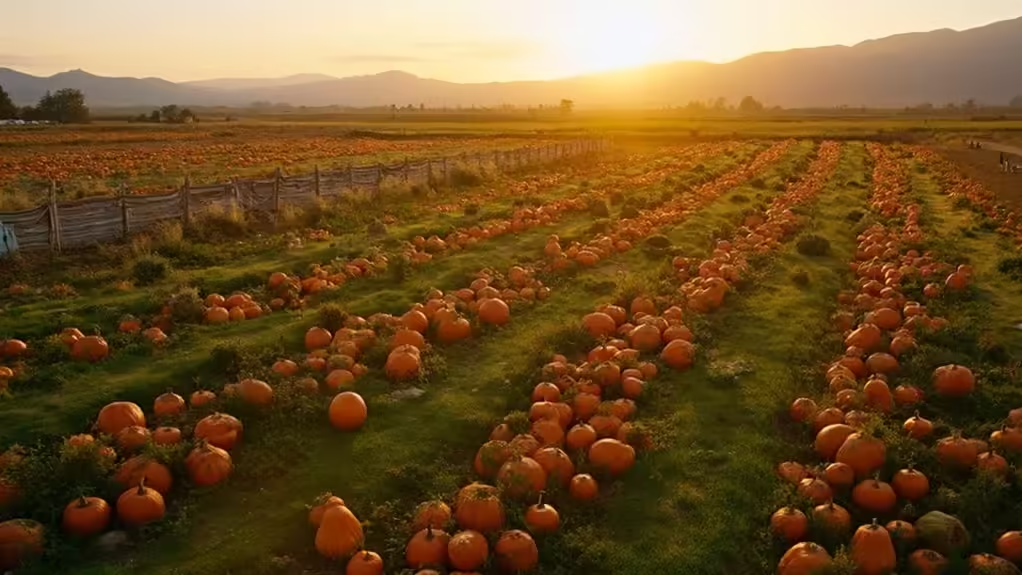California's glacier-carved valleys are breathtaking remnants of the Ice Age. You'll find these stunning U-shaped formations throughout the Sierra Nevada, with Yosemite Valley being the most famous example. Ancient glaciers, some over 3,000 feet thick, slowly carved these terrains over millions of years. They altered V-shaped river valleys into wide, flat-bottomed wonders, creating iconic features like Half Dome and El Capitan. Today, these valleys support rich biodiversity and provide critical water resources. While most glaciers have retreated, their legacy lives on in the dramatic cliffs, meadows, and unique ecosystems they left behind. Uncovering the full story of these geological marvels reveals nature's incredible power to shape our world.
Table of Contents
ToggleLearn More
- California's valleys, including Yosemite, were sculpted by glaciers during the Pleistocene epoch.
- Glacial erosion transformed V-shaped river canyons into flat-bottomed U-shaped valleys.
- Iconic formations like El Capitan and Half Dome in Yosemite showcase the results of ancient glacial activity.
- The Sierra Nevada contains over 800 mapped glaciers, with Palisade Glacier being the largest.
- Glacier-carved valleys support diverse ecosystems and provide critical habitats for numerous plant and animal species.
Geological Origins of California's Valleys
During the Pleistocene epoch, California's iconic valleys were sculpted by massive glaciers that altered the terrain. You're looking at a vista that's been dramatically changed over millions of years. The Sierra Nevada mountain range, home to many of these valleys, was born from granitic rocks long before the ice age. But it's the glacial erosion that really shaped what you see today.
Imagine yourself standing in Yosemite Valley. The steep cliffs and U-shaped contours you're admiring are the handiwork of ancient ice sheets. These glaciers, some as thick as skyscrapers, carved out the land with their immense weight and movement. They turned V-shaped river canyons into the broad, flat-bottomed valleys you can investigate now.
As you hike through these valleys, you'll spot evidence of this icy past. Look for striations – scratches in the rock that tell the story of glaciers grinding their way through. The rich soil beneath your feet is partly thanks to deposits left behind by these glaciers. It's a living proof of California's incredible geological history, waiting for you to uncover its secrets.
Yosemite: A Glacial Masterpiece
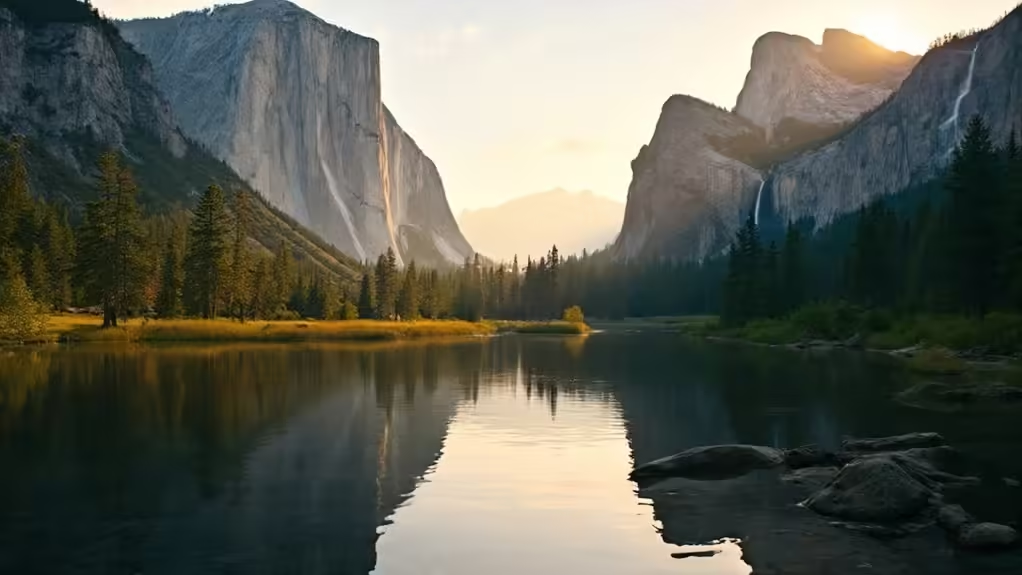
Yosemite Valley stands as the crown jewel of California's glacier-carved scenery. As you investigate this natural wonder, you'll witness the breathtaking results of ancient glacial activity that shaped the terrain during the Pleistocene epoch. The valley's iconic granite formations, like El Capitan and Half Dome, were sculpted by massive ice sheets that once covered the area.
Here's what makes Yosemite a true glacial masterpiece:
- U-shaped valley formed by powerful glaciers
- Towering granite cliffs and domes
- Glacial striations etched into rock surfaces
- The meandering Merced River, carved by ice
As you wander through Yosemite, you'll see evidence of its icy past everywhere. The Tioga Glaciation, which occurred around 26,000 to 18,000 years ago, left a lasting mark on the valley. Today, you can still spot remnants of this glacial activity in the form of striations and deposits scattered throughout the park.
However, Yosemite's glacial legacy is changing. Modern glaciers like Lyell and Maclure have shrunk dramatically since 1872, losing over 90% of their volume due to climate change. This alteration serves as a stark reminder of our changing world and the need to protect these natural wonders.
Sierra Nevada's Icy Legacy

The Sierra Nevada's icy legacy extends far beyond Yosemite Valley. You'll find over 800 mapped glaciers scattered throughout this majestic mountain range, with the largest being Palisade Glacier. These icy giants have been shaping the terrain for millions of years, carving out breathtaking valleys and leaving their mark on the region's topography.
As you investigate the Sierra, you'll witness the aftermath of ancient glacial activity that began around 3 million years ago. The last major glaciation, known as the Tioga Glaciation, occurred between 26,000 and 18,000 years ago. It's responsible for the iconic U-shaped profile of Yosemite Valley, which you can see today.
But the Sierra's glaciers aren't just relics of the past. Modern glaciers like Lyell and Maclure continue to shape the terrain, though they're rapidly shrinking due to climate change. These icy remnants have lost over 90% of their volume since 1872, a stark reminder of our changing world.
Despite their decline, the Sierra's glaciers have left behind a rich legacy. The striations and deposits they've created contribute to the region's biodiversity, ensuring a thriving ecosystem for generations to come.
Shaping Landscapes Through Time
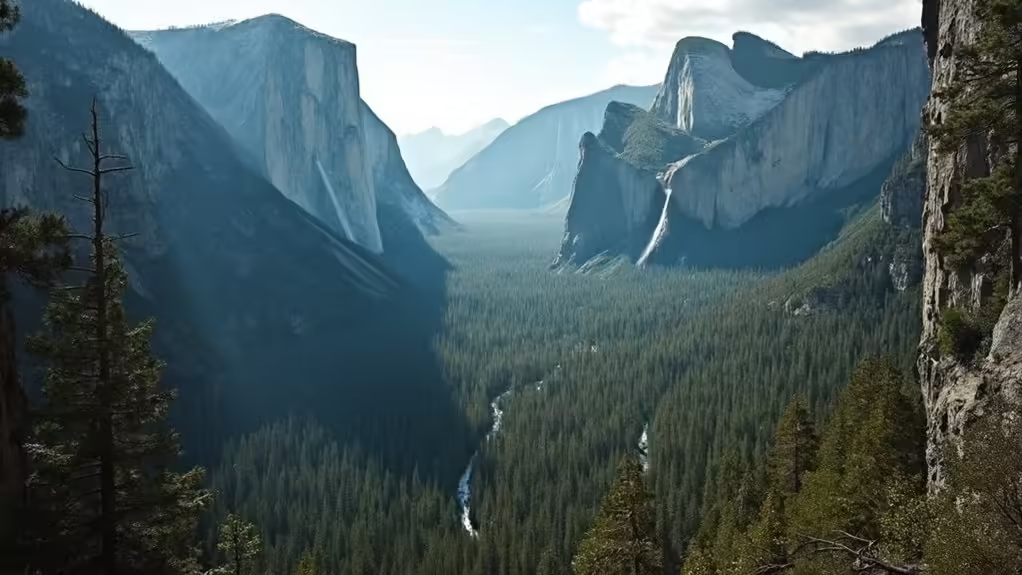
You'll be amazed by how glaciers have sculpted California's terrains over millennia. As massive ice sheets moved through the Sierra Nevada, they carved V-shaped river valleys into the iconic U-shaped formations you see today, like Yosemite Valley. This geological alteration hasn't stopped, as modern glaciers continue to shape the land and influence ecosystems, though their rapid retreat due to climate change is altering these processes dramatically.
Glacial Erosion Mechanics
While many natural forces shape our planet's surface, glacial erosion stands out as a particularly powerful sculptor of terrains. You'll be amazed at how glaciers, formed by snow accumulation over thousands of years, carve out distinctive U-shaped valleys. These icy giants bulldoze through rock, leaving behind telltale signs of their passage, like bedrock scratches called glacial striations.
In California, you can witness the breathtaking results of glacial activity firsthand. The Sierra Nevada, especially Yosemite Valley, showcases nature's raw power. During the Tioga Glaciation, about 26,000 to 18,000 years ago, massive ice sheets altered steep canyons into broad, flat-bottomed valleys.
Here's what makes glacial erosion so fascinating:
- It creates unique terrains you won't find anywhere else
- The process takes thousands of years, shaping the Earth on a grand scale
- Glaciers leave behind clues that help us understand our planet's history
- The resulting valleys often become prime locations for outdoor escapades
As you navigate California's glacier-carved valleys, you're witnessing the legacy of ancient ice flows that once dominated the terrain. It's an indication of the Earth's ever-changing nature and the freedom to investigate these awe-inspiring geological wonders.
Yosemite's Geological Transformation
Spanning millions of years, Yosemite's geological alteration has carved out one of Earth's most awe-inspiring vistas. You'll find that glacial activity in the Sierra Nevada began shaping this terrain about 2.5 million years ago. It's changed V-shaped canyons into the breathtaking U-shaped valleys you see today, giving you a glimpse into Earth's incredible past.
The Tioga Glaciation, which occurred between 26,000 and 18,000 years ago, played a vital role in Yosemite's makeover. It sculpted steep granite cliffs and expansive meadows, creating a playground for nature lovers and explorers alike. But the story doesn't end there. You're witnessing ongoing changes, as modern glaciers like Lyell and Maclure have shrunk dramatically since 1872, a stark reminder of climate change's impact.
As you navigate Yosemite, you'll notice evidence of its glacial history in striations and deposits. These clues tell a tale of ice-driven alteration that's shaped the valley's rich biodiversity. Recent studies suggest that significant carving happened within the last 10 million years, coinciding with the Sierra Nevada's uplift. This geological change continues to unfold before your eyes, offering a lively terrain that's both ancient and ever-changing.
Modern Landscape Implications
The modern scenery of California's glacier-carved valleys tells a story of continuous change and adaptation. You'll find that these terrains, shaped by glacial erosion over millions of years, continue to evolve. Yosemite Valley, once a V-shaped canyon, now boasts a distinctive U-shape, evidence to the power of ice and time.
Today, you can witness the ongoing impact of glaciers on California's terrain:
- Remnant glaciers like Lyell and Maclure influence hydrology
- Alpine ecosystems thrive on glacial meltwater
- Erosion and sediment deposition shape valley floors
- Soil fertility is enhanced by glacial processes
As you investigate these valleys, you're not just seeing static scenery. You're observing active geological processes that continue to mold the land. Climate change is accelerating the retreat of California's glaciers, affecting biodiversity and water resources. This shift serves as a stark reminder of nature's vibrant forces.
The interplay between glacial history and modern climate creates a unique terrain that's both ancient and ever-changing. By understanding these processes, you gain a deeper appreciation for the freedom and resilience of nature, even as it faces new challenges.
Biodiversity in Glacial Ecosystems
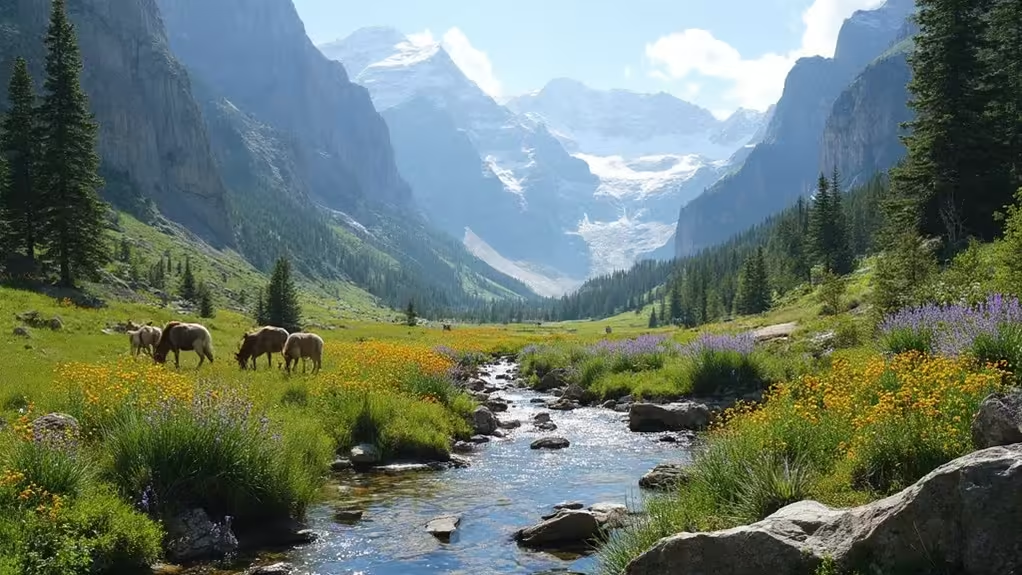
Glacial ecosystems consistently amaze with their rich biodiversity, supporting a wide range of habitats from alpine to subalpine environments. You'll find over 400 species of vertebrates in Yosemite National Park alone, showcasing the incredible variety of life these areas sustain. As you investigate these icy terrains, you'll notice unique plant communities that have adapted to thrive in harsh conditions, contributing to the overall biodiversity.
The retreating glaciers, like Lyell and Maclure, play an essential role in maintaining this diverse ecosystem. Their meltwater provides critical cold water for local flora and fauna during late summer and fall, ensuring the survival of many species. You'll see how the presence of glaciers influences soil fertility and moisture levels, which are fundamental for the growth of native plants and the wellbeing of animal populations.
As you witness the interconnectedness of glacial movements and biodiversity, you'll understand why changes in glacier health directly impact surrounding ecosystems. These glacier-carved valleys aren't just stunning vistas; they're indispensable habitats that support a complex web of life, from tiny alpine flowers to majestic wildlife.
Climate Change and Glacial Remnants
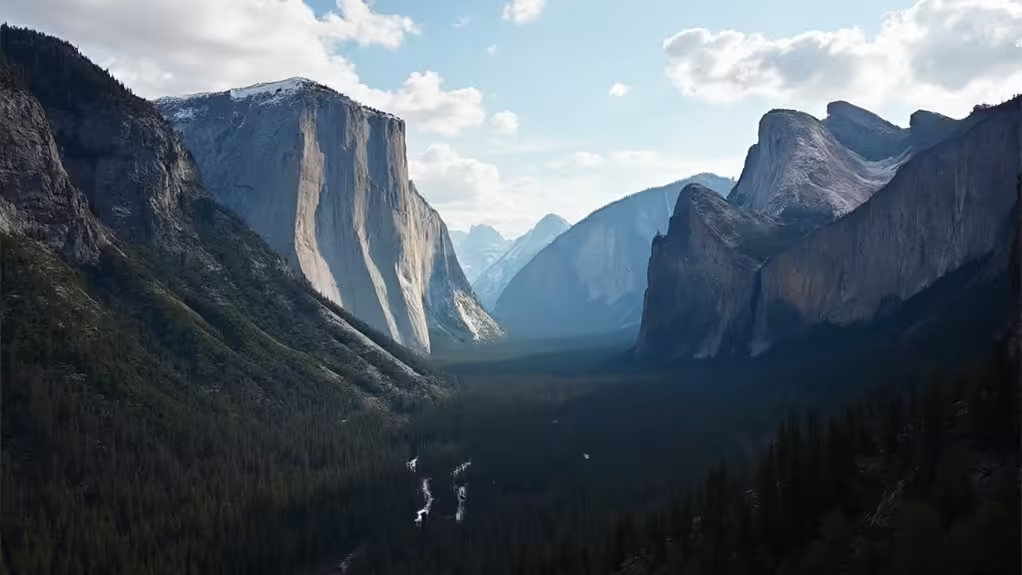
While California's glaciers have endured for millennia, they're now facing an unparalleled threat from climate change. In Yosemite National Park, the once-mighty Lyell and Maclure glaciers are rapidly shrinking, with Lyell Glacier at risk of vanishing within a decade. These icy remnants aren't just scenic wonders; they're essential to the region's ecosystems and water supply.
You might be wondering why this matters. Here's what's at stake:
- Biodiversity loss in unique glacial habitats
- Reduced late-summer water flow for wildlife and vegetation
- Altered terrains that impact tourism and recreation
- Disruption of natural climate indicators
Climate change has accelerated glacial retreat, with rising temperatures and drought conditions taking a heavy toll. You can see the dramatic ice loss through repeat photography, which shows how these frozen giants have dwindled over 140 years. The Maclure Glacier's movement has slowed from one inch to 0.75 inches per day, a clear sign of its decline. As these icy remnants melt away, they're leaving behind more than just bare rock – they're reshaping California's future water resources and ecosystem balance.
Preserving California's Glacial Heritage
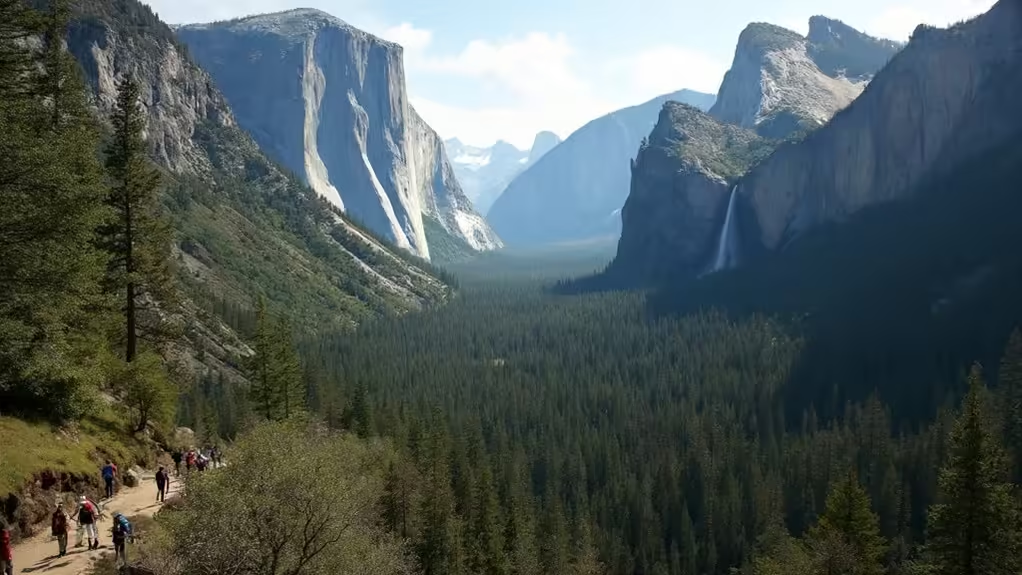
Despite their dwindling size, California's glaciers remain an essential part of the state's natural heritage. You'll find these icy remnants of a bygone era tucked away in the Sierra Nevada, where they've shaped the terrain through millions of years of glacial erosion. Yosemite National Park stands as a tribute to this glacial heritage, protecting not only the remaining glaciers but also the stunning U-shaped valleys they've carved. These glaciers, though steadily retreating due to climate change, continue to nourish ecosystems by providing a seasonal meltwater lifeline to rivers and streams. Their influence can still be felt today, from the towering granite cliffs to the fertile lands that have become home to California’s most stunning wineries, where the unique soil and weather conditions foster world-renowned vineyards. As climate concerns grow, there is ongoing research and preservation efforts aimed at protecting both these ancient glaciers and the landscapes they’ve helped shape.
As you investigate these glacier-carved wonders, you're witnessing living history. The National Park Service offers programs to help you understand the critical role these ice giants play in shaping California's diverse ecosystems. You'll learn how conservation efforts are working to preserve these fragile environments in the face of climate change.
Frequently Asked Questions
What Famous Valley in California Was Formed by a Glacier?
You've got to check out Yosemite Valley! It's a jaw-dropping U-shaped wonder carved by ancient glaciers. You'll be blown away by its towering granite cliffs, like El Capitan and Half Dome, shaped by nature's raw power.
What Is a Valley Carved by a Glacier Called?
You'll find glaciers carving, shaping, and altering. They forge valleys with steep sides and flat bottoms, liberating the land from its former constraints. These majestic U-shaped valleys stand as proof to nature's raw, untamed power.
How Can You Tell if a Valley Were Carved Out by a Glacier?
You'll spot a glacier-carved valley by its U-shape, unlike V-shaped river valleys. Look for striations on bedrock, moraines, hanging valleys, and cirques. These telltale signs reveal nature's raw power, carving out epic terrains for you to investigate.
Was Yosemite Valley Formed by a Glacier?
Yes, Yosemite Valley was carved by glaciers. You'll see the telltale U-shape and towering cliffs, products of ice's unyielding force. Nature's raw power set you free to investigate this majestic scenery, shaped over millions of years.






